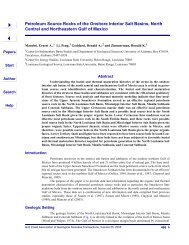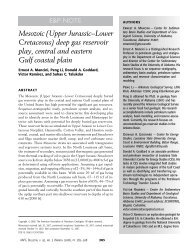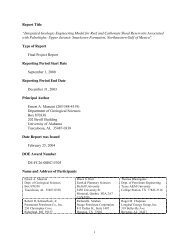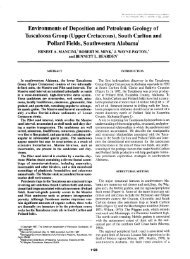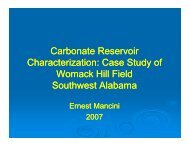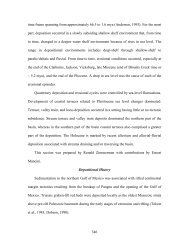Norphlet Formation (Upper Jurassic) - Berg - Hughes Center
Norphlet Formation (Upper Jurassic) - Berg - Hughes Center
Norphlet Formation (Upper Jurassic) - Berg - Hughes Center
You also want an ePaper? Increase the reach of your titles
YUMPU automatically turns print PDFs into web optimized ePapers that Google loves.
Ernest A. Mancini et al 893sand that can result in pebbles near the tops of the foresets(Glennie, 1970). Figure 6D illustrates <strong>Norphlet</strong> eoliaiisandstone filling a wadi channel. Glennie (1970) states thatthe occurrence of pebbles near the tops of the foresets isdiagnostic of wind-laid deposits.The upper part of the Denkman is generally massivelybedded (Figure 5A); however, wavy, horizontal laminations(Figure 5D) may be present. The upper <strong>Norphlet</strong> hasbeen interpreted as marine (Figure 4C, D) by Sigsby(1976), Wilkerson (1981), and Pepper (1982). The uppermost<strong>Norphlet</strong> sandstone is finer grained than the underlyingsandstones and generally contains a high percentage ofcarbonate and/or quart/ cement, particularly in the offshoreAlabama area (Figure 4D). The massive Denkman isinferred to be shoreface in origin and probably reflectsreworking of the underlying sediments by a rise in sealevel, which was initiated near the end of <strong>Norphlet</strong> depositionand continued during the early phase of Smackoverdeposition. Because many deserts border coastlines,marine sediments commonly are found in close associationwith desert deposits (Glennie, 1970). The TrucialCoast of the Persian Gulf is a modern example of this relationship(Fryberger et al, 1983). The Permian Rotliegendesdune and wadi deposits of the North Sea are alsooverlain by a gray, reworked marine sandstone (Gage,1980). The transgression was probably rapid in that fossilsand bioturbation are rare (Glennie and Buller, 1983).Interestingly, Glennie (1970) reports that, for the PersianGulf area of today, these marine sands are more susceptibleto early diagenetic alteration, including calcite cementation.In summary, the sequence of deposition of the <strong>Norphlet</strong>and associated lithofacies first included accumulation ofintertidal shale in isolated lagoons or bays along an emergingshoreline (Figure 13). <strong>Norphlet</strong> sandstone accumulationwas then initiated with the erosion of the AppalachianMountains. Conglomeratic sandstones were deposited inproximal alluvial fans, and red beds accumulated in distalalluvial fan and plain and wadi environments. Sand fromthese environments was transported toward the coastacross a desert plain. This sand was reworked into duneand interdune deposits. A marine transgression was initiatedduring the late phase of <strong>Norphlet</strong> deposition, resultingin the reworking of the underlying sediments. Themarine transgression continued during the early phase ofSmackover deposition. The rapid nature of the <strong>Norphlet</strong>-Smackover marine transgression, the deposition ofSmackover low-energy, intertidal and subtidal carbonatemuds, and the potential for early cementation in the upper<strong>Norphlet</strong> sandstone contribute to the preservation of<strong>Norphlet</strong> dune and interdune paleoenvironments.PETROLEUM GEOLOGYPetroleum traps in southwestern and offshore Alabamaare principally structural traps involving salt anticlines,faulted salt anticlines, and extensional fault traps associatedwith salt movement (Figure 2). Stratigraphy plays anintegral part in the formation of <strong>Norphlet</strong> petroleumtraps, as is evidenced by the existing fields and recent<strong>Norphlet</strong> discoveries.DOWNDIPDOWNDIPCARBONATESGNEOUS/METAMORPHIC IBASEMENT ROCKSALLUVIAL FAN/WADICONGLOMERATES ANDCONGLOMERATIC SAMDS IALLUVIAL/WADiRED BEDSMARINE SANDSFigure 13—Generalized sequence of deposition of Norplilet andassociated litliofacies in soutliwestern and offsliore Alabama(modified from Badon, 1975; WUkerson, 1981).The Flomaton gas-condensate field (Figure 14) inEscambia County, Alabama, discovered in 1968 with theHumble Oil and Refining Company Bernice S. Wessner 1well, consists of a low-relief, faulted sah anticline associatedwith the PoUard-Foshee fault system. The primarytrapping mechanism is the large down-to-the-north faultthat truncates an anticlinal nosing trend. Structural closureis evident in the northwestern and southeastern portionsof the field. Currently, 16 wells are producing inFlomaton with cumulative production through 1983exceeding 8.5 million bbl (1.4 x 10^ m') of condensate and122 bcf (3.5 X 10' m^) of natural gas. The <strong>Norphlet</strong> reservoirin the field includes wadi, dune, and marine sandstones.Porosity is principally secondary and is a result ofdecementation and grain dissolution (Figure 9C, D), generallyin the wadi and dune sandstones. Minor intergranularporosity is also found in these sandstones. Porosityaverages 13.5%, and permeability averages 10 md.The Chavers Creek and Sizemore Creek oil fields (Figure2) in Escambia County, discovered in 1984 with theInexco Cogle 1-8 1 and the <strong>Hughes</strong> Eastern ATIC 33-1 1wells, respectively, consist of elongate salt anticlines associatedwith the PoUard-Foshee fault system. The apparenttrapping mechanism is a down-to-the-south fault similarto the <strong>Norphlet</strong> petroleum trap at Mount Carmel oil field




